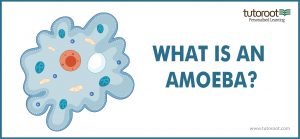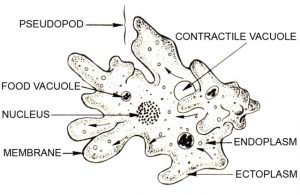What is an Amoeba? – Structure, Classification, Definition
A uni-cellular organism that has the capability to change its shape, and is commonly found in decaying vegetation, that is generally located in the water bodies, such as lakes, slow-moving rivers, and ponds. More importantly, these organisms are capable of causing various types of severe illnesses to human beings.

Besides, the Amoeba organisms are popularly known for their ability known as Amoeboid Movement. This ability involves the temporary extension of cytoplasm known as Pseudopodia. Moreover, these cytoplasms are called false feet, which these organisms actively use to move from one place to another.
Structure of Amoeba

In the above diagram, as you can see, the structure of the Amoeba consists of various components, each playing a role in the growth, needs, and evolution of the organism. Besides this, the Amoeba has certain characteristics, which make it unique and different from other organisms. Characteristics such as,
- The number of pseudopodia in particular can be multiple, and all of them have different shapes or sizes.
- There are three main components of the Amoeba – Nucleus, Cytoplasm, and Plasma Membrane.
- Unlike other living organisms, the Amoeba consumes its food through a process called phagocytosis, which involves the ingestion of other cells or particles.
- Moreover, the Cytoplasm has two different layers, inner endoplasm, and outer ectoplasm.
- It also consists of a plasma membrane, which generally comprises lipid molecules and proteins. Besides, the plasma membrane is double-layered and is very thin in size.
- Besides this, Amoeba also has the ability to transform itself into a protective ball, when it is unable to find the right living conditions or food. Once it can find the right living conditions, it can transform back to its original state.
- In amoeba, asexual reproduction is observed through the process of binary fusion, which helps the organism to produce daughter cells that are similar to the parent cells after 2 days. This amoeba reproduction makes it essentially immortal.
Classification of Amoeba
Firstly, Amoeba is classified as a type of Eukaryotes, because they consist of a true nucleus. However, unlike other living organisms, they are not included in categories like bacteria, fungi, plants, or animals. Furthermore, these amoebae are categorized into the family of Amoebidae.
Besides this, there is another sub-species of Amoeba, known as, Naegleria Fowleri. Which is commonly observed entering the human body through the nose, and it primarily feeds on the neutron inside the brain tissue. And it is the reason why they are referred to as Brain-Eating Amoeba. Other than this, there are many other amoeba subspecies, that are harmful to humans, as they cause various types of serious illnesses, as mentioned above.
Conclusion
In the above article, we have covered everything about the amoeba classification, the amoeba diagram, and amoeba reproduction. And if you find any other topics or chapters in this Subject difficult, in that case, it might be ideal for you to join the Home Tutor Online programs offered by the Tutoroot platform. Mainly because through these programs, you can access various amazing features such as Cost Effective Prices, Doubt Clearing Sessions, Access to Best Educational Materials, and many more. Visit the official platform to learn more about these features.
Frequently Asked Questions
What is nutrition in amoeba?
Holozoic is the type of nutrition employed by Amoeba. This type of nutrition involves major processes such as Ingestion, digestion, and egestion, without having any specialized organs.
How does an amoeba obtain its food?
This organism extends finger-like extensions to surround the food, making a food vacuole, where the food is broken down, especially living cells, to make it more consumable.
Where amoeba digest its food?
As you can guess from the above sections, amoeba generally digests its food in the food vacuole.
